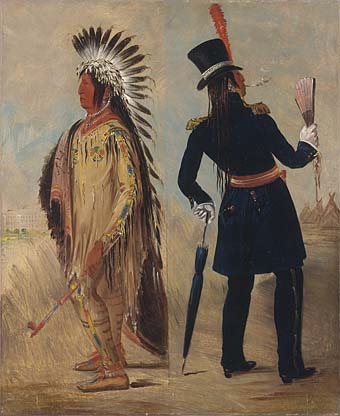“The Bureau of Indian Affairs policy toward American Indians was that assimilation, the preferred method of assimilation was through education, and the preferred method of education was boarding school, which separated children from their families and traditional culture” (Pritzker and Johansen, 501).
Bureau of Indian Affairs
The Bureau of Indian Affairs (BIA), originally the Office of Indian Affairs (OIA) was a part of the Federal Department of War. Instituted in 1824, the OIA was aimed at explicitly supporting and assimilating Indigenous populations. The department was operated by Indian agents, whom were each appointed to a particular band; there they distributed food and other goods to the band, supervised education and missionary services, and also acted as monitors of the law alongside the tribal police. There is reported evidence and accusations that many of the Indian agents acted in corrupt and untrustworthy ways. The BIA was established on the assumption that it would be a temporary measure, and later be replaced by forms of self-government or assimilation into European culture (Pritzker and Johansen, 501).
President Andrew Jackson
Andrew Jackson, like President Monroe, believed in the assimilation and removal of the Cherokee from the land they lived on for thousands of years. It appears that Jackson advocated for the relocation of the Cherokee for ethnocentric reasons, considering the fact that they successfully established Western forms of government, institutions and farming. His campaign titled Move the Indians Out, or more commonly thought of as the Trail of Tears, caused the death and injury of thousands of Indigenous people. The travel conditions along the Trail of Tears were extremely harsh during periods of the year, and the money that was supposed to be distributed by the Indian agents was often squandered (Pritzker and Johansen, 33-34).
Applications
This short expert of history from around the time the Cherokee Memorials were written can help us to understand the way the government was dealing with Indigenous populations at that time. Despite the fact that the Cherokee adopted European culture and social structure, it is grossly apparent that many government officials did not have their best interest at heart. This context gives a clear example of what the Cherokee were up against when they challenged the state of Georgia in court. However, it is important to note that not all Americans shared this ethnocentric ideology, or agreed with the removal of the Cherokee from their land. The Cherokee Memorials place us in the midst of an extensive legal battle; this information can help us to begin to understand why the Cherokee felt wronged and had such a strong desire to stand up for their rights.
References:
Pritzker, Barry and Bruce E Johansen. “Bureau of Indian Affairs: Establishing the Existence of an Indian Tribe.” Encyclopedia of American Indian History, 2008. Web. 21 March 2014.
Pritzker, Barry and Bruce E Johansen. “Indian Immigrants and Removals.” Encyclopedia of American Indian History, 2008. Web. 21 March 2014.
